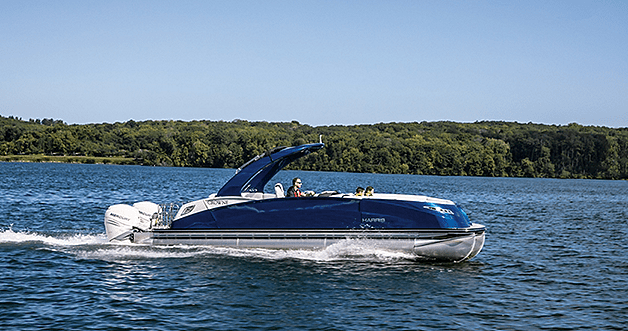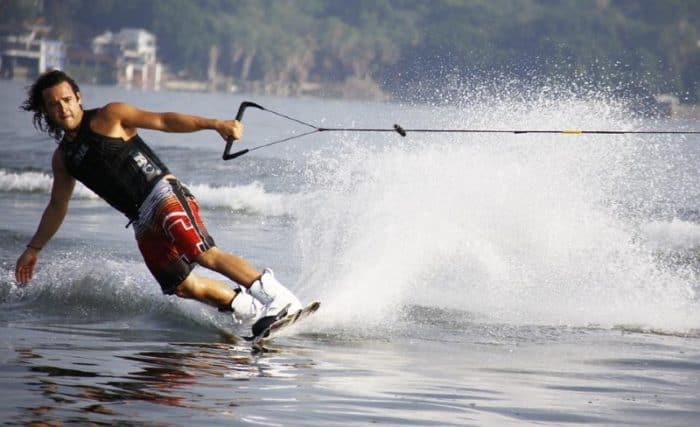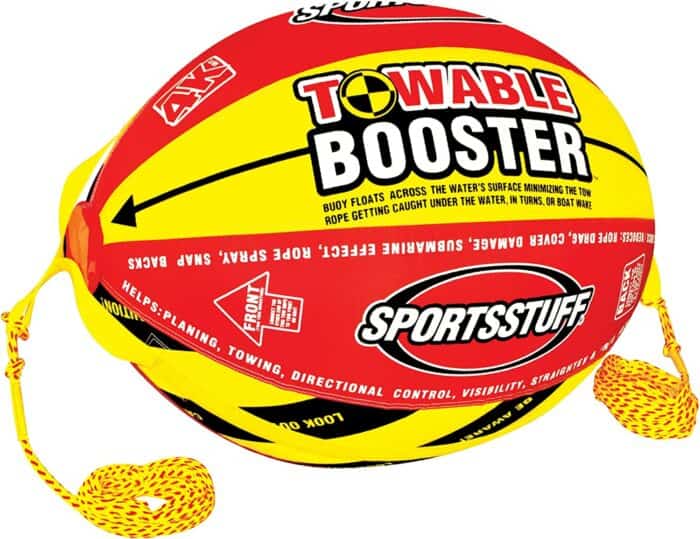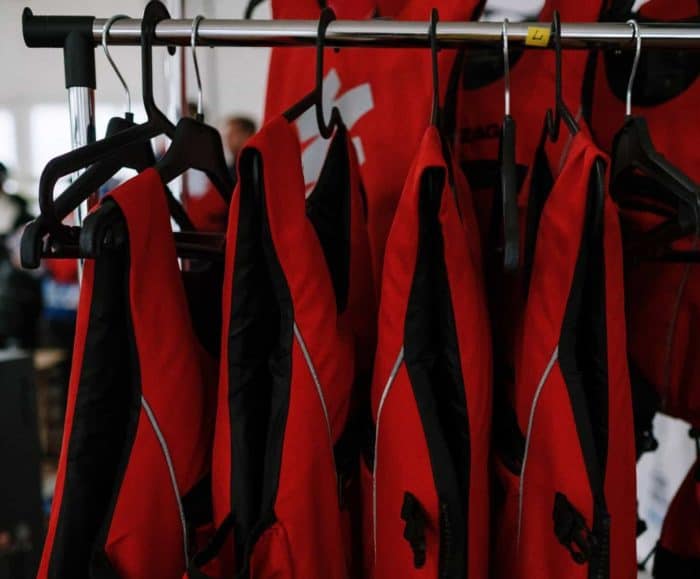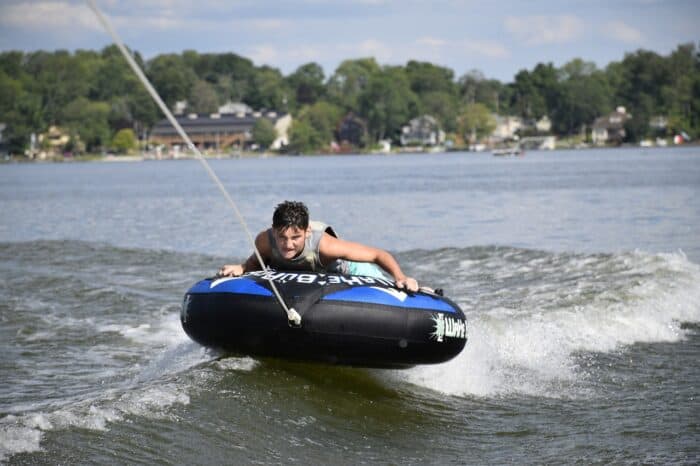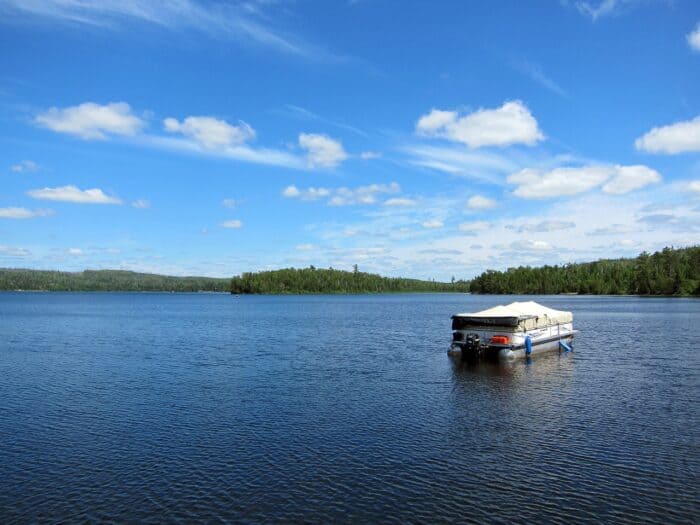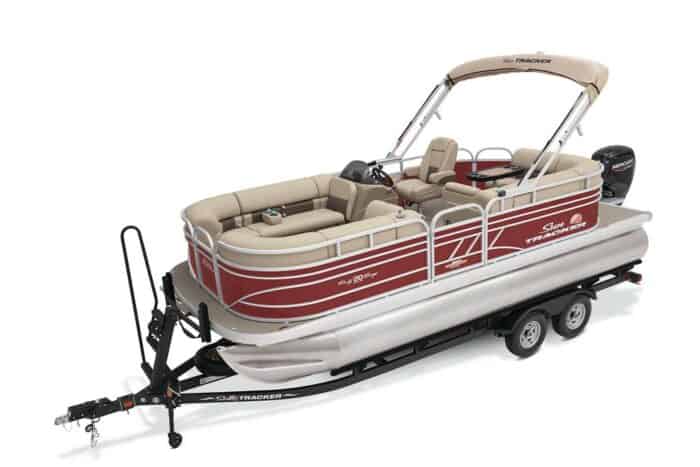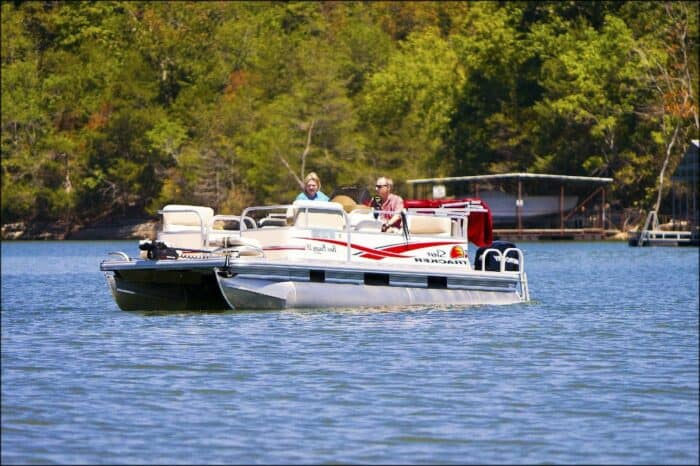Tubing Behind a Pontoon Boat
Pontoon boats have a reputation for being slow compared to things like ski boats and making sports like water skiing and tubing impossible, but that is not the case. Tubing behind a pontoon boat is possible provided your engine has the horsepower to manage the weight in the boat and being towed, your tube is able to handle the weight of the tuber, and your tow rope and tow bar are all up to the task. The size of your pontoon boat is also something to consider. If all of those factors pan out then a pontoon boat is more than just a party boat and will capable of allowing you to try tubing. Just remember, you will not produce the same kind of wake that a traditional boat will because the boat sits on the water.
Power of Pontoon Boats
There’s no hard and fast rule for what a pontoon boat must have in terms of power to guarantee you are able to tube. This is because of all the variables I mentioned above. For instance, a 16 foot boat will be able to tow someone in a tube much faster if only one person is on the boat than if there are four passengers. It’s just a simple matter of weight and what kind of strain you’re putting on your engine. So you can’t necessarily say that you must have a specific engine for this to work.
That said, I would recommend that a pontoon boat of 20 to 22 feet in length have at least a 60 horsepower engine if you’re interested in tubing. This should offer a pretty basic and simple ride overall, so don’t expect speed so fast it threatens to launch you off the tube by any means. But ti can still be fun for casual tubing with the family.
Now, if you bump the horsepower up to 90, then you will be able to draw more speed and have a much more exhilarating ride. This should allow for both towing someone on a tube at a reasonable speed while also having a few people on deck ready to have their turn as well.
At 115 horsepower and higher, then you can definitely have a good time tubing and also comfortably have a handful of people and their gear waiting on deck.
Naturally, the larger your boat is, the more passengers you’re carrying, the more horsepower you’re going to want to have. If you have a smaller pontoon boat, say under 20 feet, then you can get away with less horsepower. In part this will be because you’re also going to have less space for passengers so fewer people may be on board.
If you’re serious about tubing you need to know these things before heading out:
- The weight of the pontoon boat
- The weight of the passengers/gear on the boat
- The weight of those being towed
- The horsepower/towing capacity of your engine
Pontoon boat pull is typically never as dramatic as another kind of boat but these are versatile boats that can still do a lot. You can tube with a pontoon and have a lot of fun with some preparation.
Pontoon Tubing in Action
Check out this video of three people tubing behind an older pontoon (1973) that is 18 feet long with a 115 hp engine.
Choose the Right Tube
Tubing is a pretty blanket term for the towing of all kinds of fun things. You can go with an old school traditional donut-shaped inflatable tubes, or pick one of the open seat chariot types, or even the long, multi-passenger hotdog boats. So you need to tailor your tube to both your pontoon and what you plan to do with it. If you have small children tubing, you probably want a tube designed for a slower, safer ride than one your older teens would want to use.
By the same token, if your engine is underpowered, you’d want to pull a tube that is smaller like an inner tube, will be less likely to plow in the water, and holds fewer passengers. And don’t forget deck space on the boat. The bigger the tube the more room it will take on the deck when you have it on board before and after using it.
Some tubes are designed with coated bottoms to make them glide more easily, specifically to aid with underpowered boats and pontoons. These can really assist in making your tubing experience more fun when you have a pontoon.
Choosing a Pontoon Tow Rope
The tow rope you choose definitely affects how you can tube behind your pontoon. If you have a single rider behind the boat, you’ll want a rope with a tensile strength of about 1,500 pounds if your rider weighs around 170 lbs. But let’s say you’re using a larger tube and you’re towing multiple people. You may need a rope with a tensile strength up to 6,000 pounds at that point. Make sure you know the math for the number of people you intend to tow.
You need to ensure you have the correct kind of rope, too. Tubing rope is not the same as rope you’d use for skiing, for instance. This is due to the fact that the physics of tubing put more stress on the rope than something like skiing or wakeboarding. If you pick a rope used for water skiing and you’re towing three people on a banana boat, the line could snap and then injure someone on the tube or the boat itself.
Can You Tube with a Ski Tow Bar?
You may have a tow bar on the back of your pontoon used for water skiing. Naturally, you’d think towing a skier is the same as towing a tuber. This is not true. Check the warning label on your tow bar because there is probably one that very specifically warns that it’s for single skiers or wake boarders only.
Tubing does not work the same as skiing. Think of how you get started when you’re skiing. When you’re in the water, there’s a moment when the boat struggles to get you going. There is a ton of drag because it needs to pull you out of the water first so that you can then skim across the surface at speed.
A tube is not designed to skim across the surface the same as skis or a wakeboard. And if you have a larger tube designed for multiple riders, it will produce more drag. They can also dip unpredictably, take a nosedive, and then the stress being put on your pontoon boat increases dramatically. That’s why a tow line for tubing needs to be much stranger than one for skiing.
Your pontoon boat is already at a power disadvantage when towing, so if your tube takes a nosedive you can have literally thousands of pounds of pressure suddenly pulling your pontoon. If you’re hooking to a tow bar, you can break it right away under that force. The welds will crack and maybe pull clean off or bend right over your motor and break the cowling on it.
You are far better off tying your tow line to the eyelets or u-bolts on your pontoon’s frame. These can handle serious stress and a nosediving tube will not even shake them.
If you have a tow bar that says it’s designed for towables, check the weight limits to be sure. It needs to be able to handle potentially thousands of pounds of stress that can be put on it from a diving tube. If it can’t do that, it may not be worth the risk. When in doubt, choose the safer option.
Consider A Booster Ball
If you’re worried your pontoon doesn’t have the power to properly tow a tube, a booster ball is a great helper to make your rider smoother and more enjoyable. A booster ball looks a lot like a beach ball and it’s attached on the line between your pontoon and the tube. It adds more buoyancy to the line and keeps the front of your tube up out of the water. That greatly reduces the chances of the tube taking a dive and plowing into the water, which in turn relieves stress on your tow line, the pontoon, and its engine. With the proper set up, a booster ball can let you go faster as a result.
Understand Pontoon Tubing Safety
Even though pontoons tend to be slower than traditional hulled boats and produce less wake, they can still get a good speed. The faster you go, the faster the tube will go and the more chance that you cause some whipping that could launch the tuber into the water. Here’s where you need to be cautious again specifically as it relates to pontoons.
Maneuvering your pontoon boat back around to help a tube rider who has been ejected from the tube is a little bit harder in a pontoon than a traditional boat. It’s going to take more time to turn your boat around and head back. You need to make sure any tubers know that, if they fall in the water, you’ll need a little extra time to get to them. So, first and foremost, everyone on the tube absolutely must be wearing a personal flotation device. Having life jackets isn’t just a good idea, it’s the law in most places. Make sure you have water tubing helmets, as well. Finally, make sure they know to keep an arm up or signal you in some way so you can easily find them as you circle back.
Tips for Tubing Behind a Pontoon
Inflate it: One of the most important things you can do when tubing behind a pontoon is to keep that tube fully inflated. A lot of people overlook this or think a tube is inflated enough when it’s still a little soft and flexible. You want this thing inflated to the max. That gives it more buoyancy, more stability, and keeps it from dragging and plowing. You’ll go faster and put less stress on the pontoon as a result.
Check local laws: In some states you will need at least three people involved to tube legally. One person on the tube, of course, one to steer the boat and a third may be required to watch the tuber. It’s important to always know local laws before you engage in any activity on the water. I recommend having a person on deck to keep an eye on the tuber no matter what state laws say. It’s a good safety tip to follow anytime, anywhere.
Drop your gear: If the point of your trip is just to go tubing, unload as much gear as you can that you don’t need for the trip. Fishing gear and the like will just weigh you down and make you slower. Consider limiting passengers as well if they don’t plan to go tubing. It’s always fun to watch but if grandma just wants to see the grandkids having fun on the water, consider having her set up on shore to view so you can cut down on the weight.
The Bottom Line
Tubing behind a pontoon is not impossible by any means and, in fact, most modern pontoons have the power and capacity to make it a lot of fun. Make sure you understand the power of your pontoon boat’s engine as well as the weight of the boat plus all the passengers on board if you’re looking to do some tubing but don’t feel you have a powerful enough engine. It’s possible to go tubing with an engine that produces just 60 hp but the higher the horsepower the more speed you’re going to produce and the more intense of a ride you will be able to have and/or the more passengers can come along.
Remember to choose a rope made for tubing, not just for skiing, and cut back on gear and passengers if you find your boat is not able to handle the task. Make sure you’re following all local laws and being as safe as you can. As always, stay safe and have fun.
Categories: Pontoon Boats
